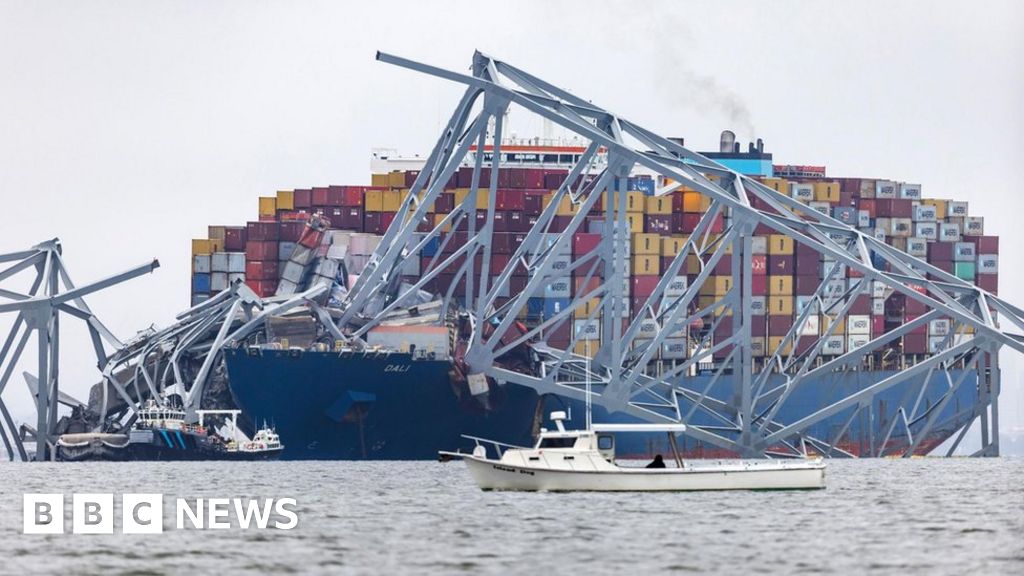image source, shutter stock
Experts say the Dali is much larger than the ship that was built when the Francis Scott Key Bridge was built in the 1970s.
Investigators recovered a data recorder from Dali’s container ship, which crashed into a concrete column supporting the Francis Scott Key Bridge in the Port of Baltimore.
Part of the 1.5-mile (2.4 km) long bridge immediately collapsed, plunging eight construction workers into the water. Two people were rescued that day, and two more bodies were recovered on Wednesday. The remaining four people are all believed to have died, and the search continues.
The ship lost power just before the collision, and the recovery of the data recorder will shed more light on why the ship broke down. The captain, crew, and two engineers are being questioned.
The investigation will focus on two key areas: what was behind the catastrophic power outage and whether the bridge should have been better able to withstand the impact.
Why does power loss occur?
Video of the accident shows Dali losing power just before the crash. The power outage may have caused the ship’s crew to lose steering control and ultimately cause them to lose control of its trajectory.
The head of the National Transportation Safety Board (NTSB) told reporters that investigators are looking into whether contaminated fuel played a role in the ship’s loss of power. Jennifer Homendy said she took samples of the ship’s fuel for testing.
Impure fuel can cause problems with ship engines and power generation.
“The vessel broke down, the steering and electronics failed,” a police officer told Fox News. “One of the engines started coughing and then stopped. The smell of burning fuel wafted through the engine room and it was pitch black.”
When power was lost, the ship drifted out of control and towards the bridge. Efforts by the crew to cushion the impact, including steering the ship to port and dropping anchor, proved futile.
“This is a really big ship,” said Sanjay Raja Arwade, a professor of civil engineering at the University of Massachusetts, Amherst. “The momentum and the energy with which it moves, even at several kilometers per hour, is tremendous.” .
Bridge from the last century
Transportation Secretary Pete Buttigieg said at a news conference Tuesday shortly after the accident that the Key Bridge was “not built to withstand a direct impact on a critical support pier by a vessel weighing approximately 200 million pounds (90,700 tons).” Only,” he said.
Key Bridge was completed in 1977. At the time, ships designed to pass through the bridge were much smaller than today’s giant ships, such as the 95,000 gross tonne Dali.
“It’s nothing compared to the ships that were sailing through the Port of Baltimore at the time,” said Norma Jean Mattei, past president of the American Society of Civil Engineers.
“Because the design life is very long, in some cases over 100 years, the demands on the structure can change in ways that are difficult to predict at the time of design and construction,” Professor Alweid said.
The NTSB’s Ms. Homendy said the bridge was in satisfactory condition, but there were no redundancies and if any part of the bridge collapsed, the entire bridge could collapse. She said this is not the preferred way to build bridges today.
Professor Alweid said it would be “very difficult or even impossible” to design redundancy into the pillars supporting long bridges.
The NTSB is investigating how well, if at all, the supporting pier was protected.Expert told The Conversation A dolphin (protective fence) appears to have been installed near the Francis Scott Key Bridge, but did not prevent ships from removing the bridge.
The bridge also appears to have lacked “fenders” (an additional layer of protection around the piers) that could have absorbed some of the impact.
Matei said mitigating risk means analyzing the probabilities when choosing where to spend your money. In the end, authorities may have decided that the chance of a huge ship hitting one of the bridge’s supports was too low to justify reinforcing it. “We only have so much money to invest,” she said.
David Knight of the Society of Civil Engineers said the collapse would cause bridge owners around the world to consider how to prevent similar disasters from happening again.
“Lessons will be learned and will help us design and build safer bridges,” he said.

